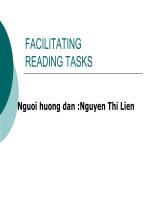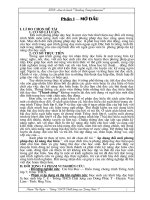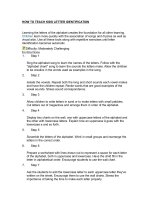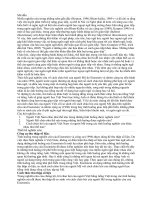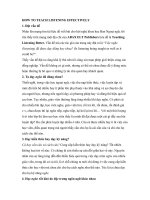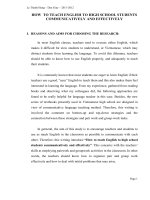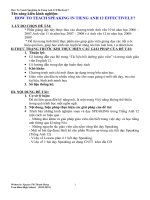How to teach reading?
Bạn đang xem bản rút gọn của tài liệu. Xem và tải ngay bản đầy đủ của tài liệu tại đây (1.29 MB, 30 trang )
What Kind of Speaking
should students do?
Speaking as controlled language
practice (Study)
Speaking as free language
practice (Activate)
What Kind of Speaking
should students do?
Speaking as controlled practice
•
Repetition – whole class
•
Question & Answer exchange – pair work or
whole class
•
Combination of repetition and sentence making
– class work
•
Sentence making – solo work or whole class
→ practice a specific bit of language
→ focus on accuracy
→ used in the Practice stage
What Kind of Speaking
should students do?
Speaking as free practice
•
Information gap – group work
•
Survey – group work
•
Discussion – group work
•
Role play – pair work or group work
→ perform some kinds of oral task
→ focus on fluency
→ used in the Production stage
Why encourage students to
do speaking tasks?
Rehearsal
•
give students a chance to rehearse having
discussion outside the classroom
Feedback
•
provides feedback for both teacher and
students
Engagement
•
good speaking activities can be highly
motivating
The roles of the teacher
Prompter
Participant
Feedback-provider
The roles of the teacher
Prompter
•
Teacher can help students and the activity
to progress by offering discrete
suggestions.
•
Students won’t feel frustrated when coming
to a dead end of language or ideas if
teacher’s help doesn’t disrupt the
discussion or force them out of role.
The roles of the teacher
Participant
•
Teacher’s participation in discussion or
role-plays
help the activity long by prompting covertly,
introducing new information.
ensure continuing student engagement and
generally maintain a creative atmosphere.
•
Teacher participate too much → students
lose opportunities for speaking.
The roles of the teacher
Feedback-provider
•
Teacher should avoid over-correction.
•
Helpful and gentle correction may get
students out of misunderstandings and
hesitations.
How should teachers correct
speaking?
•
During speaking activities in controlled
language practice, teachers often correct
every time there is a problem to achieve
accuracy.
•
During speaking activities in free language
practice, teachers cannot do the same
thing because the ultimate purpose here is
to achieve fluency. Thus, teachers should:
How should teachers correct
speaking?
Watch and listen while speaking activities are
taking place.
note down good points as well as shortcomings.
ask students point out their own mistakes and if
they can correct the mistakes by themselves
when the activity has finished.
write down the mistakes on the board or give the
mistakes individually to the students concerned.
avoid singling students out for particular criticism.
How should teachers correct
speaking?
If teachers interrupt students constantly for
correcting mistakes they will destroy the
purpose of the speaking activity and take the
communicativeness out of the activity.
In short, the general principle of watching
and listening so that teachers can give
feedback later is usually much more
appropriate.
Problems with speaking
activities
Inhibition
Nothing to say
Low or uneven participation
Mother-tongue use
Problems with speaking
activities
Inhibition
•
Learners find it difficult to say things in a
foreign language in the classroom:
worried about making mistakes
fearful of criticism or losing face
simply shy of the attention that their speech
attracts
Problems with speaking
activities
Nothing to say
•
Learners often complain that they cannot
think of anything to say. Usually, they have
no motive to express themselves beyond
the guilty feeling that they should be
speaking.
Low or uneven participation
•
In a large group, learners have very little
talking time because of some dominant
learner’s talks.
Problems with speaking
activities
Mother-tongue use
•
Learners tend to use mother tongue if they
are grouped with others who having the
same language because they find it easier
and more natural to speak their mother
tongue than a foreign language.
•
Teachers then would find it difficult to get
learners keep to the target language.
Solutions to speaking
problems
Use group work
Base the activity on easy language
Make a careful choice of topic and task to
stimulate interest
Give some instruction or training in
discussion skills
Keep students speaking the target
language
Solutions to speaking
problems
Use group work
•
increases the amount of learners’ talking
time.
•
lowers learners’ inhibitions.
•
learners may slip into their mother tongue
in their talk.
•
teachers cannot supervise all learners’
speech.
Solutions to speaking
problems
Base the activity on easy language
•
The level of language needed for
discussion should be easier → the
participants find it easy to recall or produce
the language → speak fluently.
•
It would be good if essential vocabulary is
pre-taught and reviewed before the activity
starts.
Solutions to speaking
problems
Give some instruction or training in
discussion skills
•
Learners should be given clear instruction,
told what to do, and assigned roles in a
discussion.
Keep students speaking the target
language
•
Teacher might appoint a monitor to remind
the participants to use the target language,
or she/he has to do it herself/himself.
Solutions to speaking
problems
Make a careful choice of topic and task
to stimulate interest
•
Teachers should select interesting topic
and task for learners to discuss or perform.
•
If the purpose of the discussion is clear, the
participants will be more motivated.
Speaking activities
Information gap
Survey
Discussion
Role-play
Speaking activities
Information gap
•
Definition: an information gap activity is
an activity where learners are missing the
information they need to complete a task
and need to talk to each other to find it.
Speaking activities
•
Purpose: Information gap activities are
useful for various reasons.
They provide an opportunity for extended
speaking practice, they represent real
communication, motivation can be high and
they require sub- skill such as clarifying
meaning and re- phrasing.
Typical types of information gap activities
you may find include, describe and draw,
spot the difference, jigsaw readings and
speaking, and spit dictations.
Speaking activities
Survey
•
One of the easiest & most interesting forms
of communicate activity is for Sts to tell
each about their own lives, interest,
experiences…
•
One way is getting Sts to conduct
questionnaires & survey
•
First, teacher asks Sts to look at the grip.
Think of what questions they could ask
about.
